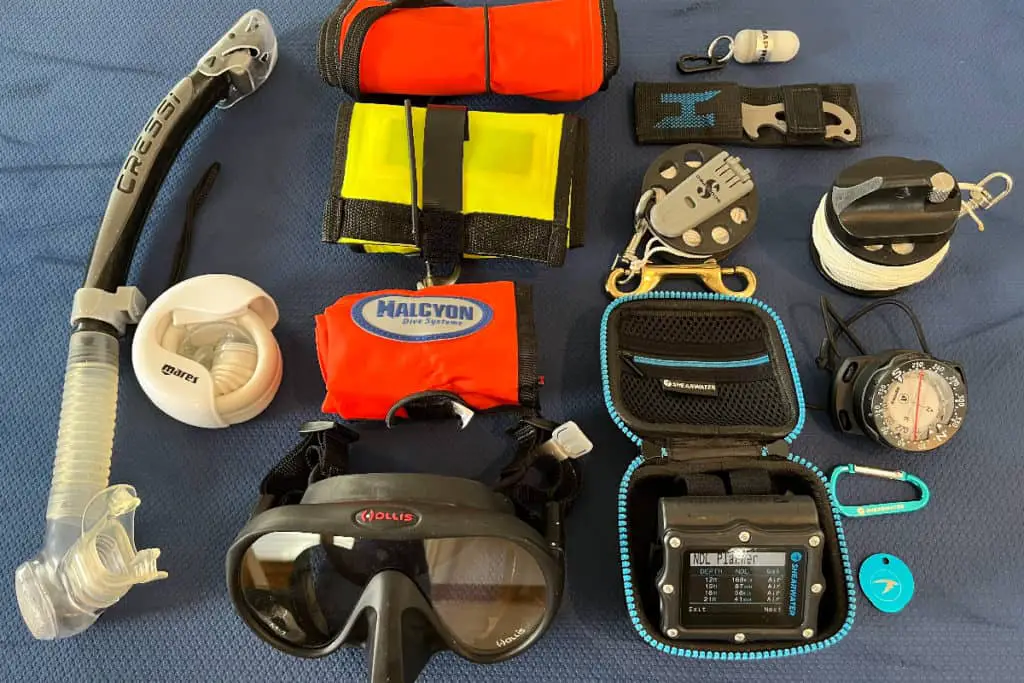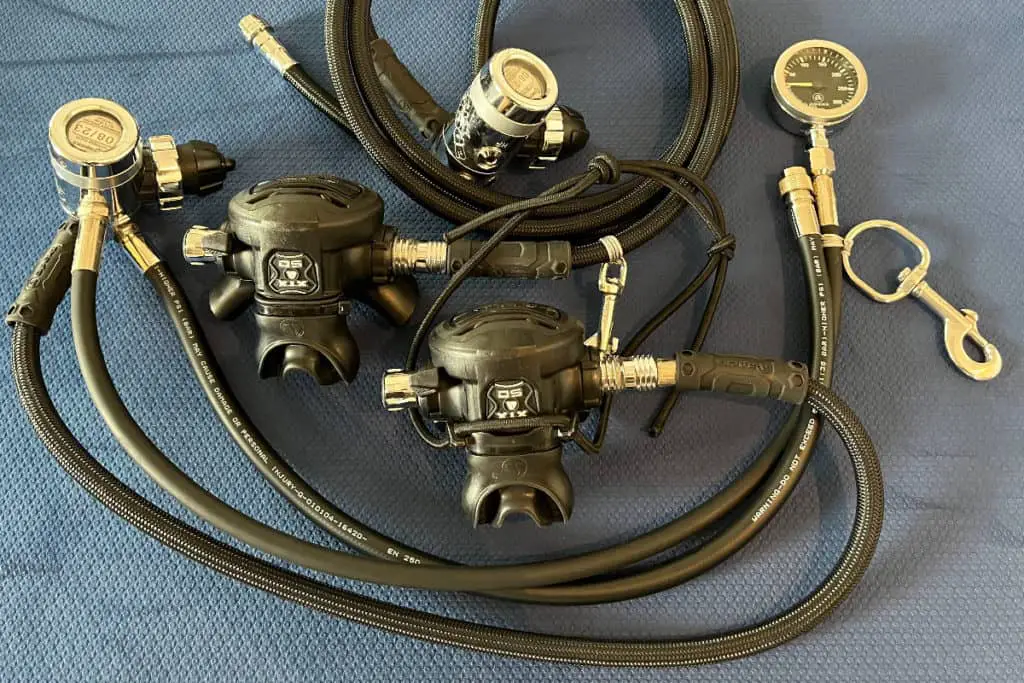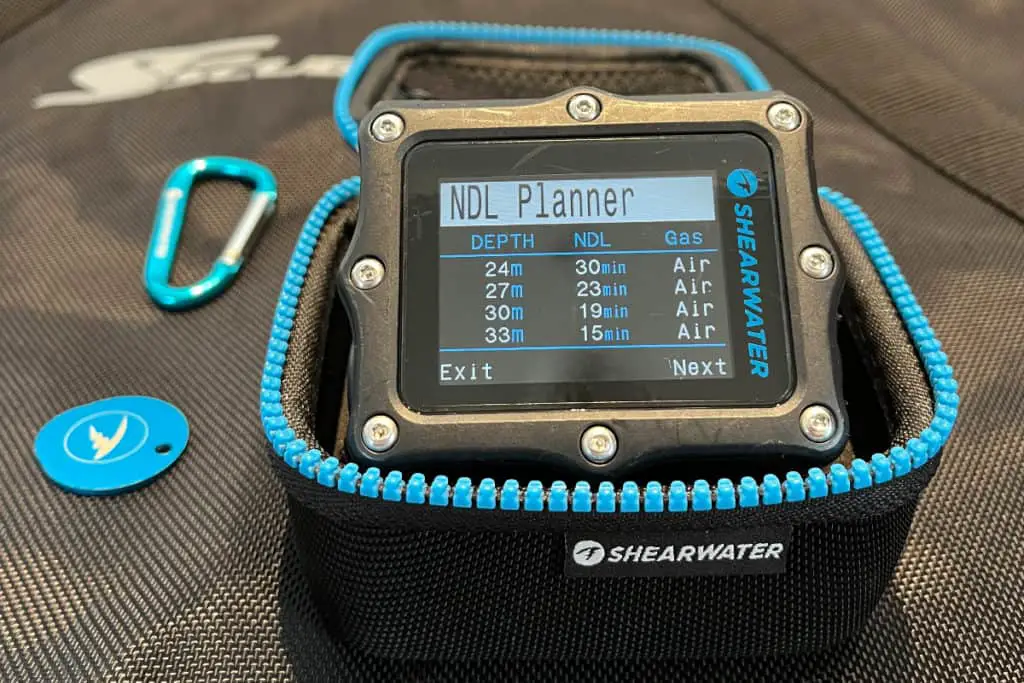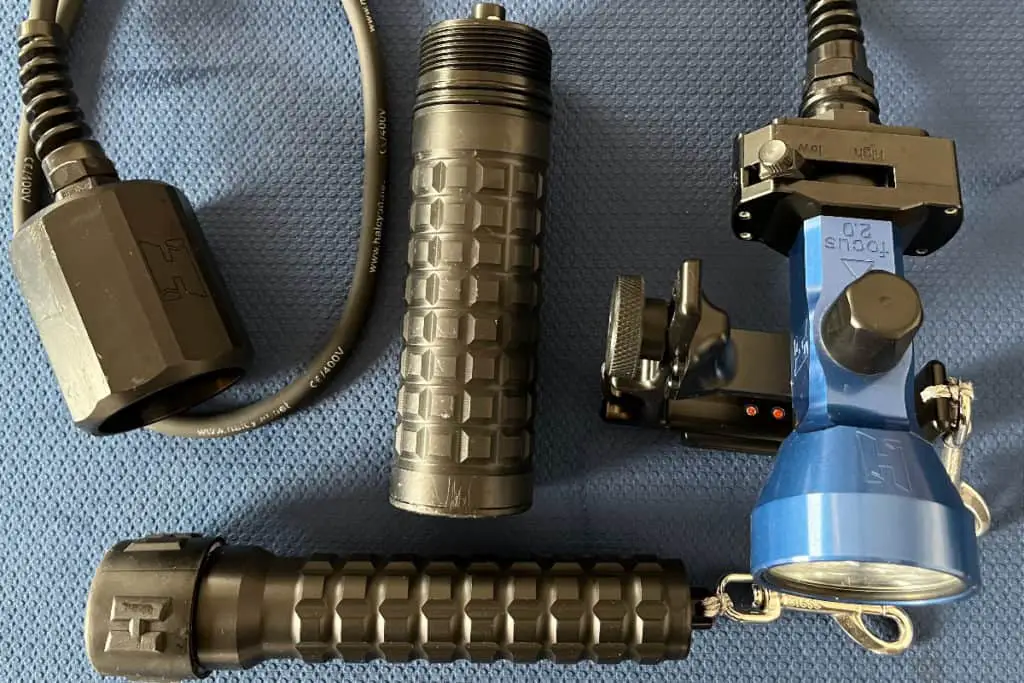
In this page you can find all the best scuba gear I own and have personally tested. I dive in many locations across the world and use different equipment depending on whether I am teaching an open water class, a deep dive specialty, having a fun dive, a technical dive or am on a scuba trip or liveaboard.
I dive equally in cold and warm water, salt and fresh. Most of my equipment is therefore suitable for all diving conditions.
Consider these as confident recommendations as I have firsthand experience with all these pieces of gear and can back it up with real world suggestions and comparisons. Working with different dive shops, I also have many terms of comparison with rental gear and often get to test products that are not yet for sale on the market.
If you are a newly certified diver or if you are more into a specific type of diving (e.g. technical dives, sidemount, only warm water) you do not necessarily need to own all the equipment I have. I have bought all my gear throughout the years and am not advising you buy it all at once. This could be extremely expensive, and you might find out that there are some pieces of gear you simply don’t need.
Although all my equipment is suitable for all types of diving, some courses have specific equipment requirements.
For example, most PADI instructors will advise against starting a PADI Open Water Diver course with a wing and backplate configuration. They will rather advise you to purchase a classic style BCD which will be easier to use in some skills such as equipment removal and replacement. By the same token, a GUE instructor will advise the exact opposite for a GUE Fundamentals class.
If you are unsure on what equipment to buy for a scuba diving course, always check with your scuba instructor or shoot me an email (scubadivingoverload[at]gmail.com), I will be super happy to support.
If you need a quick refresher on how to set up your scuba diving gear, check out my step-by-step guide.
Overview
Short on time? You will find below the detailed overview of my dive equipment. I update this scuba diving equipment list whenever I buy some new pieces of gear.
If you want to know why I use each of the pieces of equipment below, keep reading the full post.
| Category | Brand and Model | Check it Out |
| Regulator | Apeks XTX50 set | Check price |
| Regulator | Apeks XL4 second stage and octopus | Check Price |
| SPG | Apeks SPG | Check Price |
| BCD | Zeagle Ranger | Check Price |
| Travel BCD | Mares Magellan | Check Price |
| Harness | Halcyon Stainless Steel Backplate | Check Price |
| Harness | Halcyon Stainless Steel Backplate (S) | Check Price |
| Wing | Eclipse | Check Price |
| Wing | Evolve | Check Price |
| Wetsuit 3mm | Mares Graph-Flex Men’s 3mm | Check Price |
| Wetsuit 5 mm | Mares Dual | Check It Out |
| Wetsuit 7 mm | Waterproof W4 | Check It Out |
| Drysuit | Scubaforce Xpedition | Check Price |
| Drysuit | Waterproof D1X | Check it Out |
| Dive Computer | Shearwater Perdix 2 | Check Price |
| Mask | Hollis M1 | Check Price |
| Fins | Apeks RK3 HD | Check Price |
| Snorkel | Dive Rite Foldable Snorkel | Check Price |
| DSMB | Sub Gravity DSMB | Check Price |
| Spool/Reel | Scubapro Finger Reel | Check Price |
| Case | Pelican Cases | Check Price |
Don’t get impressed by this list of dive gear, it took me some time to buy all these pieces of equipment and I do not suggest to any diver to rush into buying all the scuba diving gear at once.
My Scuba Regulators

The regulator of choice for fun diving, technical diving and diving trips is the Apeks XTX50. Instead of using the Apeks XTX50 second stage and octopus, I use two XTX50 second stages. This increases reliability of my rig in case I am doing some particularly demanding dives or technical dives.
Next to the XTX50 second stages, I have two Apeks DST first stages (DIN version). The Apeks DST first stages are over-balanced diaphragm first stages with four low pressure ports and two high pressure ports each. The DST also has a rotating turret, which is useful to reduce pressure on the hoses while diving.
The Apekx XTX50 second stage and DST first stage can be bought as a kit meaning that first and second stage are usually sold together. This is one of the most widely used regulator sets by technical divers and has now been tested for years without failures being reported. It is designed for cold water diving and can be used in warm water as well. The first stage is environmentally sealed and can be used with Nitrox (up to 40% Oxygen mixes).
An Apeks Tek SPG Pressure Gauge completes my regulator set. I have tried several Tek SPGs and was quite unlucky as they have all broken within a couple of dives. I have done around 200 dives with the Apeks Tek SPG and it’s still working perfectly. This is a no-nonsense, easy to read SPG which I recommend to any diver. If you prefer an SPG with a protective coating, o would recommend the classic Apeks SPG. I use it on my XL4 set and it works perfectly.
My Apeks XTX50 is currently mounted on a long hose configuration with full redundancy as I am diving mostly in cold water at the moment. This is why you see that each second stage is mounted on a different first stage.
When I am teaching beginner level diving courses or am diving with buddies that have only a few dives on their shoulders I use the Apeks XL4 regulator set. The set includes an Apeks XL4 second stage (black), and Apeks XL4 Octopus (yellow) and an Apeks DB4+ compact first stage.
The Apeks XL4 is a compact and lightweight regulator set for diving in all environments including cold water. Its design and light weight make it ideal to use as travel regulator as it is relatively lighter than the XTX50. Just like the XTX50, the Apeks XL4 has been on the market for quite some years and has therefore been widely tested by many divers. It is one of the premium regulator sets with the highest price to quality ratio.
My Scuba BCDs, Wings, and Backplates
When it comes to BCDs I use my Zeagle Ranger for teaching beginner level PADI classes or for short trips. When it comes to really short trips such as a diving weekend, I bring along my Mares Magellan BCD.
The Zeagle Ranger is simply one of the best BCDs on the market and is super stiff and versatile. Besides being rugged, it has quite a big storage and lift capacity, making it perfect for teaching or conservation activities. If you like to carry around many accessories, you will find its huge pockets quite comfortable.
The Mares Magellan has no competition when it comes to travel BCDs, it is fully foldable and easily fits into a carry-on luggage or even backpack.
However for fund dives, while teaching advanced diving courses, or when I go on longer scuba trips, nothing can beat my Halcyon backplate and wings. I have two classic halcyon stainless steel backplates with one Evolve (when I dive doubles) and Eclipse wing (when I dive a single tank). Halcyon might not be the cheapest brand among all scuba diving producers, but is definitely one of the most rugged, developed by divers for divers. All their products have been used and tested in highly demanding dives and are used by divers requiring the highest standards of quality and safety.
If you prefer wing and backplate diving I definitely recommend you to check out the Halcyon product line.
Scuba Wetsuits
When it comes to wetsuits, I have 3 main wetsuits which I alternate with the ones from my dive shop. I have tested them all in salt and fresh water, while teaching and in fun dives.
For warm water locations the wetsuit of choice is a 3mm single piece Mares Reef wetsuit (almost identical to the Mares Graph Flex 3mm). This is a very thin wetsuit that I use in water temperatures starting from 80°F (27 °C). It is an extra light wetsuit that is also suitable for snorkelling and that can be easily carried in your luggage while travelling.
When diving in water temperatures from 68°F (20 °C) I use a 5mm two piece Mares Dual wetsuit. I find it particularly comfortable while diving from a boat as you can simply remove the upper layer during your surface interval if the air temperature it too hot. The Mares Dual also has an integrated hoodie, making it particularly comfortable also in colder water temperatures.
While diving in cold water ranging from 41°F to 68°F I sometimes use my 7mm Waterproof W4 wetsuit. If the water temperature is particularly cold, I top it up with a Waterproof 5mm hooded vest. This is a particularly expensive set up that I only recommend if you are not into drysuit diving.
Scuba Drysuits
Given that I dive throughout the year, during the autumn and winter months I definitely prefer staying dry and ward and use a drysuit.
My primary drysuit is a custom made Scubaforce Xpedition combined with a Scubaforce Arctic X Undergarment. Scubaforce is a Germany-based scuba brand, mostly oriented towards Technical Diving. It produces a full range of scuba products both for recreational and technical diving. It was founded in Germany by technical divers and I find the quality of its products simply amazing.
It is also quite efficient when it comes to delivery times of custom-made products if compared to other brands such as Santi and DUI.
As a backup wetsuit I use a Waterproof D1X. Although this is less comfortable than the Scubaforce Xpedition (e.g. back zipper vs. front Zipper), it is quite useful in warmer waters due to its 3D mesh drysuit concept which allows to wear a thinner undergarment.
If you are looking to buy a scuba drysuit, check out my ultimate guide on How to Choose the Perfect Scuba Diving Drysuit. You will find complete information on average prices, materials, options to choose from such as seals, gloves, valves, and boots.
Dive Computer

When it comes to dive computers, I like to have something versatile, powerful, reliable, that I can use in different dive profiles.
The dive computer of choice is the Shearwater Perdix AI. This is the most powerful dive computer currently available on the market, commonly used by technical and recreational divers alike.
The Shearwater Perdix AI has a wide (5.1”x 4.1” x 2.8”) colour screen, easily readable in all visibility conditions. It is lightweight and supports multiple transmitters in case you are diving with independent cylinders.
If you are looking to buy a dive computer and are willing to make a good investment, the Perdix AI is definitely the best computer you can have.
Note that Shearwater has released a newer version of the Perdix AI, called Perdix 2. I have tested it and it has lots of new functionalities such as vibration alerts.
Scuba mask and snorkel
If you need a rugged scuba mask with a wide field of vision, the Hollis M1 is the mask of choice. I have bought mine back in 2018 and have now done more than 2000 dives with it. Not a single scratch nor a break in the silicone.
If you have a beard or moustache, the Hollis M1 is also a perfect fit in that its thin silicone skirt will minimize the risk of leaks.
Note that the M1 comes with Hollis’ classic silicone head strap. You might want to buy a neoprene strap separately for greater comfort.
The Hollis M1 is just one among the many scuba divig maksks available in the market. If you are looking to buy a new diving mask, check out my step-by-step guide. If you will be diving in sunny weather conditions, you might also consider getting a polarized dive mask.
Unfortunately Hollis does not produce snorkels, I have therefore bought a separate classic snorkel from Tusa and a foldable silicone snorkel from Mares. This is one of the best options if you don’t like to dive with a snorkel but don’t want to give up on safety while at the surface.
Fins
I am currently diving with my Apeks RK3 HD fins. I have them in small (black) and medium size (grey) and change them based on the type of drysuit I am using. They are one of the best fins as they are rigid, rugged, and allow for different finning techniques.
I sometimes alternate the Apeks RK3 HD with the Scubapro Jetfins and with the Mares X-Stream.
Torches and Back Up Lights

Whether I am night diving or diving in extremely low visibility I carry with me a primary canister torch and a secondary backup light.
The canister lights of choice are the Halcyon Focus 2.0 with EO Chord and the Ammonite System LED Nautilus without EO Chord. They are both top of the line focusable torches that can be used in different environments. For example, with a narrow light beam they can be used for signalling whereas with a wide light beam they can be used to shoot videos or to enjoy a night dive.
Both the Halcyon Focus 2.0 and the Ammonite System LED Nautilus can be carried on a plane with the appropriate batteries. Remember to check the Lithium batteries requirements of your airline whenever traveling with torches or canister lights.
As backup light I use a simple Halcyon HP Led Scout Torch. It has an amazing grip even if you are diving with stiff drysuit gloves.
DSMBs
I have several DSMBs that I alternate primarily for teaching purposes. Whenever I am doing a fund dive or am on a scuba holiday, I like to carry with me my Halcyon DSMB. It is small, compact and can be inflated with a single breath, reducing the amount of time I am not keeping my regulator in my mouth.
As all Halcyon products, their DSMB is quite expensive and you might want to consider a cheaper version from Sub Gravity.
If you need some guidance on how to choose the right DSMB or SMB, check out my step-by-step guide. You will find useful tips on the different shapes, colours and sizes of DSMBs and in which occasion they are most appropriate.
Spools and Reels
If you are using a spool or reel primarily to deploy a DSMB, then any simple finger spool is sufficient. Do not overdo it with the length as you just risk of getting entangled if you are not familiar with the procedure yet.
I use a Halcyon Defender Pro Reel and a Scubapro basic finger reel for teaching purposes.
Travel Luggage and Cases
Travel luggage is a bit of a controversial topic in scuba diving. I have tried many bags over the years and always ended up breaking them due to the heavy weight.
After trying many solutions, I came to the conclusion that scuba diving luggage produced by scuba brands (e.g. Mares, Scubapro, Apeks) is good when it comes to small dimensions. For bigger luggage, you will need to look at other options.
When I travel with my scuba gear, I use luggage from The North Face. For long trips I use The North Face Rolling Thunder 36’’ . This is simply the best heavy-duty luggage if you need to travel with all your scuba equipment. It is also waterproof so that it won’t leak if you didn’t have enough time to dry up your equipment.
For shorter trips I use The North Face Rolling Thunder 30’’ and as backpack I use Northface Basecamp XS.
To carry more delicate equipment such as my regulator or canister torches, I use Pelican Cases. I find the Pelican Mod 1520 one of the best options as it is small and at the same time can accommodate several pieces of equipment.
Pelican cases need no introduction, they are rugged, sturdy, used by military forces worldwide.

